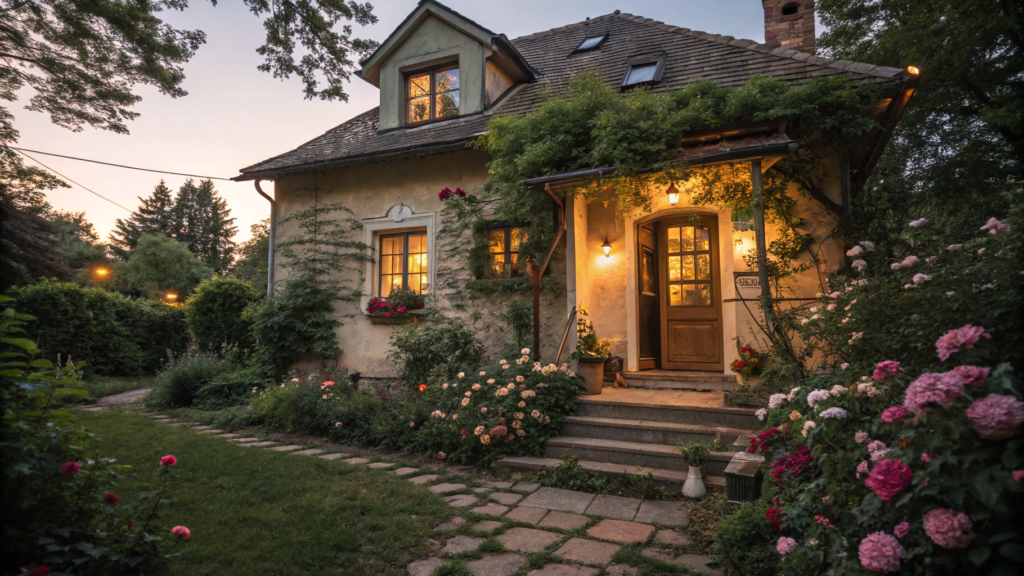South of France Aesthetic 8 Summer Vibes You’ll Love
My grandmother always said I had terrible taste in clothes. She wasn’t wrong until I discovered the South of France aesthetic
At thirty-two, I was still dressing like a college student who’d raided the clearance rack. My closet was stuffed with polyester blouses that pilled after two washes and jeans that never quite fit right. Getting dressed every morning felt like a chore, and I looked tired even when I wasn’t.
Then my job sent me to Cannes for a conference. I packed my usual business casual disasters and prepared to feel underdressed for three days straight.
What happened instead was a complete awakening.
On my last morning there, I ducked into a small café away from the conference crowds. The owner was probably sixty-something, wearing what looked like the simplest outfit in the world – loose white pants, a faded blue cotton shirt, and brown leather sandals that had clearly walked a thousand miles.
She moved like she owned the place (which she did), but more than that, she moved like she owned herself. Her gray hair was twisted up messily, she had no makeup I could detect, and her shirt had a small coffee stain near the pocket. But she was absolutely magnetic.
I watched her for twenty minutes, refilling my cup twice just to stay longer. She laughed with customers, argued playfully with the delivery guy, and hummed while she worked. Everything about her presence said “this is who I am, take it or leave it.”
That woman taught me something I’d never learned in thirty-two years: style isn’t about impressing other people. It’s about feeling so comfortable in your own skin that you forget to worry about what anyone thinks.
Table of Contents
What I Learned About Real French Style and the South of France Aesthetic
After that trip, I became obsessed. I went back to southern France three more times, but instead of staying in tourist areas, I rented apartments in regular neighborhoods. I shopped where locals shopped, ate where they ate, and paid attention to how women my age actually dressed.
Here’s what surprised me: most of them weren’t wearing anything particularly expensive or trendy. But they all looked incredible.
The difference was in how they chose things. They seemed to understand their bodies, their lifestyles, and their preferences in a way that let them shop with confidence. A woman would try on a dress, look in the mirror for about ten seconds, and either buy it or put it back. No agonizing, no asking friends for opinions, no second-guessing.
They also seemed to care more about how things felt than how they looked. I watched women touch fabrics before even looking at prices, checking if sleeves moved comfortably, making sure waistbands sat right. Comfort came first, but somehow that led to looking better, not worse.
The colors were different too. Instead of black everything, I saw lots of creams, soft blues, sage greens, and warm terracotta. Colors that looked like they belonged in sunlight instead of fluorescent office lighting.
The 8 Things That Changed How I Dress Forever
1. Linen Became My Religion
I used to avoid linen because I thought it looked sloppy. Turns out I was buying terrible linen and trying to make it behave like cotton.
Good linen has weight to it. It drapes instead of bunching up. It wrinkles, sure, but the wrinkles fall in natural lines that somehow look intentional. Bad linen (the stuff I was buying online for $25) wrinkles into chaos and makes you look like you slept in a dumpster.
My linen education happened at a market in Aix-en-Provence. This vendor let me feel the difference between machine-made and hand-woven linen. The good stuff felt substantial but soft, like it would get better with every wash. The cheap stuff felt like scratchy paper.
What to buy first:
- A button-front shirt in white or cream (you’ll wear this twice a week)
- Straight-leg pants that actually fit your hips
- One dress in whatever color makes you happiest
- A light jacket for evening or air conditioning
Keep the colors that you see in old stone houses and herb fields. Bright linen looks cheap and fights against the relaxed mood you’re going for.
Care instructions that actually work: Wash in cold water, shake out while wet, hang immediately. Don’t fold it perfectly. Let it have texture.
2. My Face Got Simpler and Better
French women taught me that good skin beats perfect makeup every single time. Instead of covering everything up, they seemed focused on making their natural features look healthier.
I threw out half my makeup collection and started over with basics. The goal became looking like myself on a really good day, not like someone else entirely.
My new five-minute routine:
- Moisturizer with SPF (no negotiation on this one)
- Tinted lip balm in a berry shade
- One coat of brown mascara
- Cream blush when I look washed out
- That’s it
For special occasions, I might add eyeliner or a second coat of mascara, but the base stays the same. The key is good skincare underneath – moisturizer morning and night, weekly face masks, drinking enough water.
Hair-wise, I stopped fighting my natural texture. I use leave-in conditioner on wet hair, scrunch it up, and let it air dry. If it’s too wild, I braid it or twist it up. The goal is to look like you just came back from a great day outside.
3. My Home Started Telling Stories
The French approach to decorating completely changed how I think about my space. Instead of trying to make everything match, I started choosing pieces that felt meaningful or beautiful to me personally.
I began shopping at estate sales and antique stores, looking for things with character instead of perfection. That wooden cutting board with knife marks from decades of use? It has more personality than anything I could buy new. The ceramic bowl with a small chip? It’s still beautiful, maybe more so because of its history.
Ways to add authentic character:
- Use real books as decoration, ones you’ve actually read
- Keep fresh herbs growing in whatever containers you have
- Choose natural materials when you can – wood, stone, cotton, wool
- Display things you use regularly instead of hiding them
- Let plants grow naturally instead of keeping them perfectly trimmed


The secret is patience. I used to want to decorate everything immediately, but now I wait until I find pieces I genuinely love. My apartment feels more personal this way, less like a furniture store display.
4. Colors That Actually Work Together
Understanding color was like learning a new language. Once I figured out which shades naturally belong together, getting dressed became so much easier.
The South of France palette comes straight from the landscape:
- Blues from pale sky to deep Mediterranean water
- Greens like olive leaves and herb gardens
- Warm earth tones like terracotta roof tiles
- Creams and whites like limestone walls weathered by sun
These colors work together because they exist together in nature. When you wear a sage green dress with cream sandals, it looks perfect because you might see those exact shades in a Provençal garden.
The key is to pick slightly muted versions of these colors instead of ones that are too bright or fake. Think sun-faded, lived-in, softened by time and weather.
In your home, use these colors in fabrics, pottery, artwork. They create a sense of calm that makes any space feel more peaceful.
5. Regular Life Got More Beautiful
This might be the most important change I made. Instead of saving nice things for special occasions, I started treating regular days like they mattered.
I began using my good dishes for everyday meals, lighting candles during weeknight dinners, and drinking morning coffee from my favorite mug instead of whatever was clean. These tiny changes made ordinary moments feel more special.
Small luxuries that cost nothing extra:
- Setting a proper place at the table even when eating alone
- Using cloth napkins (they feel so much better than paper)
- Taking time to arrange flowers from the grocery store
- Playing music while cooking instead of watching TV
- Eating slowly enough to actually taste your food
This is what French people mean when they talk about “joie de vivre” – finding joy in everyday life. It’s not about spending more money; it’s about paying attention to details that make life richer.
6. Confidence Without the Performance
Real elegance doesn’t announce itself. It’s quiet, comfortable, sure of itself without needing to prove anything to anyone.
I used to ask for opinions on every outfit: “Does this look okay? Should I change?” Now I choose things I genuinely like and trust that authenticity is more attractive than following every trend.
Building this kind of confidence:
- Stop explaining your choices to other people
- Learn what cuts and colors work on your body and stick with them
- Buy fewer things but choose them more carefully
- Find a signature scent and make it yours
- Practice accepting compliments without immediately deflecting them
The most elegant women I observed in France weren’t necessarily the most conventionally beautiful. They were the ones who seemed completely comfortable being exactly who they were.
7. My Home Smells Like Provence
Smell may be the most overlooked way to set the mood. Good smells make any space feel more welcoming and luxurious.
Instead of expensive candles, I started using natural sources of fragrance. Fresh herbs growing on my windowsill, lemon peels in the garbage disposal, lavender sachets in my closet drawers.
Simple ways to make your space smell incredible:
- Grow rosemary, basil, and mint in small pots
- Use water and essential oils to create your own room spray.
- Keep fresh flowers around, even cheap ones from the supermarket
- Use coffee grounds as a natural deodorizer
- Hang bundles of dried herbs in your kitchen


After my second trip to Provence, I started making lavender sachets. It’s embarrassingly simple – dried lavender tied up in fabric scraps – but they make everything smell like a Mediterranean dream.
8. Trying Less, Living More
This is the hardest concept to explain because it goes against everything we’re taught about effort and achievement. French women seem to understand that the most attractive quality is being genuinely comfortable with yourself.
It’s about moving through your day like you belong wherever you are. Ordering what you want at restaurants without apologizing. Wearing what makes you feel good instead of what you think you should wear. Taking up space in conversations without feeling like you need permission.
Ways to embrace this mindset:
- Stop rushing through everything like it’s an emergency
- Make real eye contact when talking to people
- Sit up straight (it changes how you feel about yourself)
- Learn to say no to things that drain your energy
- Choose experiences over accumulating more stuff
The goal isn’t to become someone else. It’s to become more authentically yourself, just with clearer boundaries and better priorities.
Making This Work on My Actual Budget
Let me be completely honest – I’m not rich. My salary is decent but not extravagant, and I had to figure out how to do this without going into debt.
The secret is changing from quantity to quality thinking. Instead of buying five cheap shirts that fall apart after a few months, I save up for one really good one that looks better every time I wear it.
Budget strategies that actually work:
- Start with one key piece and build slowly around it
- Shop estate sales and consignment stores in nice neighborhoods
- Learn basic alterations so things fit perfectly
- Focus on free changes like morning routines and home organization
- Buy classic pieces at end-of-season sales
Most importantly, remember that the best parts of this aesthetic don’t cost anything – slowing down, appreciating beauty, treating yourself with care.
What Definitely Doesn’t Work
I’ve made every possible mistake while figuring this out. Here’s what to avoid:
Don’t aim for perfection. The whole appeal is beautiful imperfection – slightly wrinkled linen, undone hair, the lived-in feeling. If everything looks too polished, you’ve missed the point entirely.
Don’t ignore your real life. If you have kids, pets, or a job requiring different clothes, adapt these ideas to work with your actual circumstances. The principles still apply even if the execution looks different.
Don’t copy everything exactly. The women who do this best understand the concepts but make them personal. Your version should reflect your own personality and lifestyle.
Don’t try to change everything overnight. Building authentic personal style takes time. Enjoy discovering what works for you instead of rushing to transform everything immediately.
Where You Go From Here
The South of France aesthetic taught me that real style isn’t about following rules perfectly – it’s about understanding timeless principles and adapting them to your own life. You don’t need a European vacation or unlimited budget to embrace these ideas.
Start with whatever speaks to you most. Maybe it’s buying that linen piece you’ve been considering, or creating a morning routine that feels nurturing, or simply paying more attention to colors and textures that bring you happiness.
That café owner in Cannes wasn’t performing for anyone. She was simply living her life with intention and self-respect, and that made her absolutely radiant. That’s the real lesson – this aesthetic teaches you to slow down and find beauty in ordinary moments.
Which of these eight vibes calls to you most? Are you ready to embrace the beautiful messiness of linen, or does the idea of everyday luxury feel more appealing? Tell me in the comments how you’re planning to make this aesthetic work in your own life – I love hearing about everyone’s different approaches!







